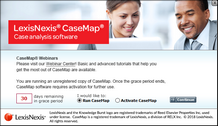The CaseMap client application is installed to the Microsoft® Windows® desktop of any CaseMap user. If you are using the CaseMap SQL version, the install utility will prompt you to enter the URL to the CaseMap Server. The URL should end with CMServerClient.svc.
CaseMap installs as an unregistered trial copy. There is a 30-day grace period to use CaseMap. Once the grace period expires, CaseMap will no longer function. The unregistered copy of CaseMap works identically to the registered version. If you are reinstalling over a registered version of CaseMap, you will not need to re-register.
CaseMap client installation overview:
| • | CaseMap must be installed and run on a local hard drive. |
| • | CaseMap may not be run from a network server. |
| • | You must be signed into your computer on with administration rights to install CaseMap. |
| • | CaseMap data files can be stored in a file on a network drive or in a Microsoft® SQL Server® database. |
| • | Cases created with previous versions of CaseMap may require conversion to the current data format before they can be opened in the current version of CaseMap. |
| • | CaseMap DocPreviewer and DocManager as optional plug-ins, which are downloaded with CaseMap and require an additional license for activation. |
| • | CaseMap plug-ins for Microsoft Word and Microsoft Outlook are optional installation components. |

|
Cases must be converted to the current version format. After a case is converted, previous CaseMap versions cannot open it. Upgrade each instance of CaseMap that will work on the converted case. For details, see Converting cases.
|

|
Installing a new version of CaseMap replaces any current installation of the Send to CaseMap plug-in for Adobe Acrobat with a new version. The new plug-in may work in earlier versions of CaseMap, though some features may be disabled. We recommend that you do not upgrade to a new version of CaseMap until you are ready to stop using earlier versions of the product and can migrate previous version cases to the current CaseMap version.
|

|
You can install the latest CaseMap client application version to a desktop that already has previous versions of CaseMap installed. It will not remove the prior version.
|
| 1. | Run the CM14Setup.exe file.
The CaseMap Install utility starts. |
| 2. | When the InstallShield Wizard launches, click Next. |

| 3. | In the License Agreement dialog box, click Yes. |

| 4. | In the Information dialog box, review the installation information, then click Next. |

| 5. | In the Default CaseMap Server dialog box, type the default CaseMap Server name and the URL for CaseMap Server, then click Next. |

This dialog box only displays if you are installing CaseMap Server.
| 6. | In the CaseMap Microsoft Office Plug-ins dialog box, select plug-ins you want to install: Microsoft Word and Microsoft Outlook are choices. Clear the check box for a plug-in you do not want installed. |

These plug-ins allow case users to send data from Word or Outlook to a case.
| 7. | In the Choose Destination Location dialog box, verify whether the default destination folder is the appropriate location, then click Next. |

The default folder is C:\Program Files (x86)\CaseSoft\CaseMap 14.
| 8. | In the Start Copying Files dialog box, review the current settings, then click Next. |

| 9. | In the InstallShield Wizard Complete dialog box, click Finish. |

CaseMap starts.
|
| 1. | Start CaseMap if it is not already started. |
| 2. | In the Welcome to CaseMap dialog box, select Activate CaseMap, and then click Continue. |
| 3. |  |
| 4. | In the CaseMap 14 Software Activation dialog box, click Next. |
| 5. | Provide registration details and then click Next: |
| • | In the Registration Name field, type in your user name for license registration. |
| • | In the Registration ID field, type in your registration ID. |
| • | In the Product ID field, type in the CaseMap license number. |

|
You must be registered with LexisNexis as a valid user of this software to have this registration information. When you register with LexisNexis, you should receive this information via email or phone.
|
| 6. | Read the license agreement and then select Yes, I will abide by the LexisNexis License Agreement if you agree to the terms, and then click Next. |

| 7. | Select an activation method and then click Next: |

| • | Activate software online — Use this option to activate online with an active internet connection. |
| • | Activate by web browser or phone — Use this option if you received an activation key via email. |
| 8. | In the summary dialog box, review the license registration information and then click Next. |
| 9. | Click Finish, and then in the confirmation message box, click OK. |

| 10. | CaseMap starts and you can begin using it. |
|












